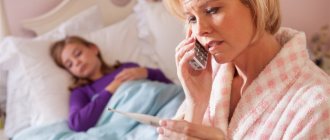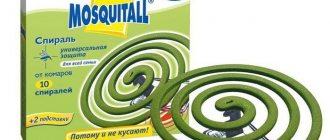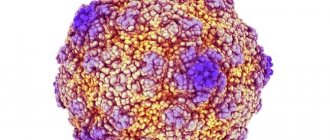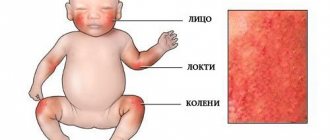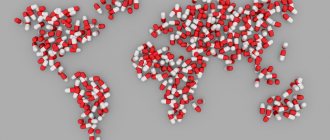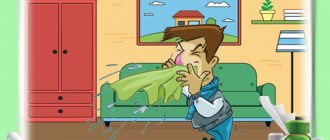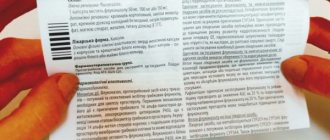Use of drugs for hyperactivity in children
The advisability of using drugs for hyperactivity in children is periodically questioned.
To understand, you need to define the very concept of hyperactivity syndrome. Attention deficit hyperactivity disorder is a disorder of higher nervous activity that is often diagnosed in young children. Complications during pregnancy or childbirth can provoke the development of this condition in a child.
A child suffering from hyperactivity has great difficulty concentrating and also finds it difficult to control his behavior. This is due to the fact that the child’s nervous system has difficulty processing incoming information. At the same time, persuasion and punishment have practically no effect - the hyperactive child remains impulsive and restless.
How to treat hyperactivity in children
The main approach to treating children with attention deficit hyperactivity disorder should be comprehensive and include both medications and pedagogical and psychological correction.
With the help of nootropic and metabolic drugs, the child is able to better adapt to everyday life. In order to select the correct dose of the drug, consultation with a specialist is necessary.
Medicines have the following therapeutic effects:
- Reducing the level of impulsivity and excitability in response to external stimuli.
- Improved learning ability and concentration.
- Increased performance.
- Improving learning of educational material and developing new skills.
- The child’s behavior becomes more orderly, and his activities become purposeful.
- Improving coordination of movements, including fine motor skills.
In Western countries, it is widely practiced to treat hyperactivity in children using drugs from the group of psychostimulants. However, such drugs have a large number of side effects.
Very often, treatment with such drugs is accompanied by the development of insomnia, psychomotor agitation and headache. In our country, such treatment of children is not practiced.
In Russian pediatric and neurological practice, it is more common to treat children with the use of nootropic drugs.
This group includes medicinal substances that have a positive effect on the higher integrative functions of the brain.
The choice of drug depends on the predominant syndrome in a particular small patient. If the child's primary concern is distracted attention, a greater effect can be achieved by using nootropic drugs. These medications include Cortexin, Gliatilin, Encephabol.
If the leading syndrome is hyperactivity and disinhibition, treatment is carried out mainly with the help of gamma-aminobutyric acid derivatives. These drugs include Pantogam and Phenibut. They control inhibitory functions in the brain.
Only a neurologist or child psychiatrist should prescribe such drugs. You should not try to prescribe treatment for your child yourself.
Treatment with Gliatilin
Gliatilin is a drug that belongs to the class of neuroprotectors. Widely used in the treatment of ADHD and other brain diseases of an organic and functional nature.
The pharmacological effect is to restore metabolic processes and normalize blood flow in the brain tissue. Thanks to the effects of Gliatilin, conductivity in the tissues of the cerebral cortex improves.
In the human body, Gliatilin breaks down into two main active substances - glycerophosphate and choline.
- Choline takes part in the synthesis of the neurotransmitter acetylcholine. Thanks to this active substance, the speed of transmission of nerve impulses and the exchange of information between tissues and nerve cells significantly increases.
- The cell membrane of neurons contains phospholipids. Their main component is the substance glycerophosphate. It significantly increases the resistance of nerve cells to negative external factors.
Thanks to the effects of Gliatilin, brain functions impaired due to hypoxia are restored and the child’s cognitive abilities are increased, concentration and the formation of new skills are improved.
Gliatilin in pediatric practice
Despite the fact that reference books and instructions for use do not contain data on the possibility of treating children with this drug, domestic pediatricians and neurologists have extensive positive experience in treating minor patients with the following diseases:
- Consequences of birth injuries and organic brain diseases.
- Delayed mental and psychomotor development.
- Attention deficit hyperactivity disorder.
- Signs of early childhood autism of various origins.
For children under 2 years of age, the drug is indicated in injection form. For older children, the medication is prescribed in the form of gelatin capsules. Typically, the course of injection procedures lasts from 10 to 15 days. When prescribing the drug orally, the course of treatment should be from 1 to 3 months. The dosage is determined by the attending physician based on the patient’s age and body weight.
The only contraindication to the use of this drug is possible individual sensitivity to its components. If unpleasant symptoms such as nausea occur, the dosage of the drug can be slightly reduced. If a urticarial rash appears, you should stop taking the medication and seek help from a specialist.
There are drugs on the pharmaceutical market with similar properties and active ingredients, but with a different trade name. However, only a specialist can replace the drug.
Treatment with Cortexin
Cortexin belongs to the group of nootropic drugs and stimulates metabolic processes in brain tissue. The use of this drug helps improve higher mental functions. This allows the child to improve his learning ability and assimilate a greater amount of new information.
Cortexin perfectly protects brain tissue from the effects of hypoxia and various toxins. Improving the functions of the nervous system allows brain neurons to recover much faster from adverse external influences.
The use of this drug helps restore the structure and function of neurons after suffering stress. In addition, this medication suppresses excessive pathological activity of neurons and has an anticonvulsant effect.
By suppressing the process of lipid peroxidation, Cortexin helps neurons better survive in hypoxia.
It has been noticed that after treatment with Cortexin, children begin to speak much better and remember new material. The child's speech becomes smoother. Stuttering may disappear.
The amino acid glycine, which is part of the drug, has an additional effect. The medicine is available only in the form of a lyophilized powder, which is diluted and administered intramuscularly. It is best to give the injection in the shoulder area.
In children under the age of six months, muscle mass is small, so injections are made into the front surface of the thigh. It is best to give this injection in the morning between 7 and 8 o'clock.
This allows you to avoid a large number of side effects that the substance can cause.
It should be remembered that the powder causes noticeable pain when administered, so it is better to dilute the medication with a solution of Novocaine or Lidocaine at room temperature. However, if a child has an allergic reaction to local anesthetics, the medicine is diluted with distilled water or saline solution.
The prepared diluted drug should not be stored - it must be administered immediately and in full.
The full therapeutic course lasts 10 days. After six months you can repeat it if necessary.
The dosage of the drug depends on the child’s age and body weight. If a child weighs more than 20 kg, the drug is administered in a dose calculated for an adult. For infants and children weighing less than 20 kg, there is a special dosage calculation table.
You should not deviate from the regimen prescribed by your doctor or try to change the duration of treatment or dosage on your own.
The drug can be administered even if you have a cold - this is not a contraindication. The medicine goes well with antipyretic substances. There is even an opinion that with the introduction of Cortexin, the child’s body copes with colds faster and more effectively.
Pantogam in tablets and syrup
Pantogam is a drug based on gamma-aminobutyric acid. This substance controls inhibition processes in the brain. It is available in the form of syrups or tablets for oral use.
You can take the drug 30 minutes after your next meal. You should not take the medicine at night - your child may have problems falling asleep. The dosage is prescribed by a neurologist depending on the age of the child.
The duration of treatment can range from several months to six months. Then it is recommended to take a break for 3-6 months, after which the course can be repeated if necessary.
The effect of taking the drug can be increased with the help of complex treatment. While taking the medicine, there is a decrease in the child’s signs of anxiety or hyperactivity, and an increase in perseverance and ability to concentrate. In addition, the drug affects the pathological activity of brain neurons and has an anticonvulsant effect.
Source: https://roditeliz.ru/family/preparaty-pri-giperaktivnosti-u-detej-lekarstvo.html
Hyperactive child
Experts find it difficult to determine the exact causes of attention deficit hyperactivity disorder. It is believed that hyperactivity in children may be caused by genetic factors and early organic damage to the central nervous system, which are often combined with each other. Modern research indicates that in ADHD there is a mismatch in the functioning of the structures that ensure the organization of voluntary behavior and control of attention, namely the associative cortex, basal ganglia, thalamus, cerebellum, and prefrontal cortex.
The genetic mechanism of ADHD is explained by the inheritance of genes that regulate the exchange of neurotransmitters (dopamine and norepinephrine) in the brain. Due to dysfunction of neurotransmitter systems, the process of synaptic transmission is disrupted, which entails a disconnection of connections between the frontal cortex and subcortical structures. This theory is supported by the fact that in the treatment of hyperactivity in children, drugs that promote the release and inhibition of the reuptake of neurotransmitters in presynaptic nerve endings are effective.
Among the pre- and perinatal factors that determine the development of ADHD, we should note various types of adverse effects that contribute to the development of minimal brain dysfunction in a hyperactive child. It could be:
- pathological course of pregnancy and childbirth in the mother (preeclampsia, eclampsia, threatened miscarriage, hemolytic disease of the fetus, rapid or prolonged labor,
- pregnant women drinking alcohol or certain medications, smoking),
- asphyxia, prematurity, birth injuries in a child, etc.
- infectious diseases and TBI suffered in the first months and years of life.
The formation of hyperactivity in children cannot be ruled out by the influence of unfavorable environmental factors, primarily pollution of the natural environment with neurotoxicants (lead, arsenic, mercury, cadmium, nickel, etc.). In particular, a correlation has been proven between increased lead content in hair according to spectral analysis and the level of hyperactivity, cognitive and behavioral disorders in children.
The occurrence or intensification of the manifestations of ADHD may be associated with an unbalanced diet, insufficient intake of micronutrients (vitamins, omega-3 fatty acids, microelements - magnesium, zinc, iron, iodine). Unfavorable family relationships contribute to increased difficulties in adaptation, behavior and attention in a hyperactive child.
Treatment of hyperactivity in children with medications: drugs
Recently, children are increasingly diagnosed with hyperactivity. This is one of the types of diseases of the nervous system, which in most cases goes away on its own. However, parents should not ignore it. Various methods are used to treat hyperactivity: drug therapy, folk remedies, exercises, the influence of a psychologist, etc.
Excedrin
One of the medications used to treat hyperactivity is Excedrin. It is not prescribed to children under 15 years of age. The drug belongs to the group of psychostimulants and has many contraindications.
In addition to Excedrin, other medications are used to treat hyperactivity.
What is hyperactivity?
ADHD (hyperactivity) is a syndrome of increased mental and physical activity in which excitation predominates over inhibition. The disease is associated with disruption of the central nervous system.
Hyperactive children are too active and find it difficult to sit in one place for a long time. They are inattentive and have problems with learning and memory. The brains of children with ADHD have difficulty processing information.
Symptoms of hyperactivity in children:
- emotional instability, tearfulness;
- restlessness;
- anxiety;
- sleep problems;
- bad behavior;
- speech delay and others.
How to treat hyperactivity in children?
The best place to start fighting hyperactivity is by visiting a doctor. First of all, you need to contact a pediatrician who, after examining the child, will give a referral to the required specialists.
Treatment of ADHD should be comprehensive, including not only drug therapy, but also other methods of influence. An important place is occupied by psychological and pedagogical correction, proper nutrition.
Drugs
Treatment of hyperactivity in children with medications should be carried out under the supervision of specialists. Only a doctor can select the exact dosage and determine the duration and effectiveness of therapy.
The following groups of medications are used to treat ADHD:
- psychostimulants;
- sedatives;
- nootropics;
- norepinephrine drug.
It is also important to take vitamins.
ADHD medications can achieve the following effects:
- reduce impulsivity and reduce excitability;
- improve mental activity, which manifests itself in increased learning ability;
- improve performance;
- develop new skills;
- improve behavior;
- increase the ability to control your own emotions;
- develop fine motor skills.
Medicine for hyperactivity in children is selected depending on the prevailing symptoms.
Psychostimulants
Psychostimulants are actively used in the treatment of ADHD in children with medications:
- Ritalin is a medication that helps reduce hyperactivity and impulsivity, improve concentration and the overall quality of life of a child;
- Excedrin - the basis of the drug is psycholeptics and acetylsalicylic acid, has many contraindications (glaucoma, vitamin deficiency and others), is intended for adolescents aged 15 years and older.
The dosage of psychostimulants is determined strictly by the doctor. Otherwise, side effects may occur: dizziness, headaches, and the appearance of nervous tics.
Vitamins
Vitamin complexes must be taken along with medications for ADHD. They strengthen the child's immune system and help him fight the disease.
The following types of vitamins are relevant:
- B vitamins (thiamine chloride, B1) - a synthetic drug, soluble in water, takes part in improving brain activity and restoring the functioning of the central nervous system;
- Vitamin A is a fat-soluble substance used not only for hyperactivity, but also for other disorders of the nervous system.
Despite the apparent safety of vitamins, it is important to take them in a certain dosage. Otherwise, you may encounter hypovitaminosis, which is fraught with undesirable consequences.
Sedatives
Among the sedatives used to treat ADHD in children, the following are often used:
- Magne B6 is a complex vitamin that enriches the body with magnesium and improves mental activity;
- Persen - tablets have a mild effect on the children's nervous system;
- Glycine is an amino acid that helps provide emotional relief, calm and normalize sleep, and improve brain activity;
- Citral is an antiseptic, has anti-inflammatory and analgesic effects, approved for the treatment of preschool children, released in the form of a suspension;
- Pantogam - has a calming effect, relieves seizures, and is used to treat hyperactivity in children only in extreme cases.
Nootropics
Neurometabolic stimulants restore metabolic processes in nerve cells and improve brain function. The following nootropics are used to treat hyperactivity in children:
- Piracetam – enhances the synthesis of dopamine in the brain, helps improve metabolic processes in it, is available in capsule form;
- Gliatilin is a nootropic drug that improves attention, memory and thinking, which occurs by restoring blood circulation in the brain; it is better to use injections for treating children;
- Cortexin – has an antioxidant effect on the child’s body, provides protection to cells from free radicals, is available in the form of injections;
- Noopept – has a neuroprotective effect, improves memory, increases learning ability, is available in tablet form;
- Phenotropil is a nootropic that has psychostimulating and calming properties, presented in the form of tablets.
The list of nootropic drugs is quite wide. The specific medication and its dosage must be selected by the attending physician.
Norepinephrine drug
One of the main representatives of norepinephrine drugs is Digitalis. It is rarely used to treat children under one year of age. The drug consists of herbs, so it has virtually no contraindications. It is forbidden to use it only if you are allergic to one of the components of the product.
Digitalis is a homeostatic drug that is poisonous in large dosages.
This is not the entire list of drugs that are used to treat hyperactivity in children. Neuleptil, Mexidol and even dietary supplements are often used.
Traditional methods
Along with drug treatment, folk remedies help get rid of hyperactivity in children. How exactly to use them - separately or in addition to traditional therapy - is decided by the doctor. Treatment of hyperactivity in children with folk remedies involves taking herbal infusions and decoctions orally, as well as using them in the form of baths.
Herbs
There are several recipes for preparing herbal decoctions and infusions that help alleviate the symptoms of hyperactivity in children:
- pour dried angelica rhizomes (10 g) with boiling water (0.5 l) and leave for 6 hours, wrapping the container in a warm towel or blanket, drink 1 tsp. three times a day;
- pour a few tablespoons of hop cones into 300 ml of water, put on fire and cook for about 1 minute after boiling, then leave for half an hour, drink 10 ml 3 times a day;
- prepare a decoction of St. John's wort: pour the crushed dry raw material (15 g) with a small amount of boiling water so that it covers the herb, boil for 15 minutes, and then drink chilled, 2 tsp. twice a day;
- Brew 10 g of lavender flowers in 300 ml of boiling water and leave for half an hour, take 15 ml 2 times a day.
Herbal baths
Herbal baths relax the body and nervous system. To prepare one of these, you need to mix 50 g of dry calamus rhizome, 20 g of juniper fruits and 20 g of willow bark.
Pour the resulting mixture into 3 liters of water and put on fire. Simmer after boiling for about 15 minutes, and then leave for another half hour.
Pour the freshly prepared broth into a bath of water and perform the procedure for 20 minutes.
It is not necessary to take such a bath every day; it is enough to prepare it every other day for 1.5 months.
Lifestyle correction
A hyperactive child must live according to a schedule and also adhere to the following rules:
- go to bed on time and wake up in the morning;
- eat well;
- take more frequent walks before bed;
- do exercises in the morning and generally lead an active lifestyle.
If a child becomes interested in any sport, do not prevent it. Athletics, swimming, gymnastics, etc. are suitable.
Nutrition and diet
A hyperactive child's menu should include many foods containing complex carbohydrates (beans, cereals, starchy vegetables). Scientists have proven that such food increases the level of serotonin in the blood, which is precisely what is lacking during hyperactivity.
It is important to exclude simple sugars from the patient’s diet. They contribute to an instant burst of energy, but normally it should be produced gradually. Products containing simple sugars are confectionery, sweet fruits, white bread and others. It is also advisable to avoid the use of dyes, preservatives and other harmful substances.
In addition to complex carbohydrates, the diet should contain a lot of protein, which promotes concentration and generally participates in important processes in the body. To achieve the desired effect, you need to include more meat, nuts, and fish in the menu of a child with hyperactivity.
Recent research has shown the benefits of zinc for ADHD. Therefore, you need to include seafood and cereal dishes in your child’s menu. It is worth enriching your diet with foods that increase the level of Omega-3 in the blood, such as avocados, salmon meat and others.
Exercises
To eliminate symptoms of hyperactivity in children, the following types of exercises are recommended:
- development of fine motor skills - quickly and alternately fingering the fingers, combining them with the thumb, closing and opening the ring;
- on a flat surface, the hand alternately performs three positions, which successively replace each other: palm on a plane, clenched into a fist, placed with an edge;
- sit on the floor, close your eyes and listen carefully to the sounds around you.
The first two exercises are a kind of massage for developing fine motor skills, and the last one helps develop attentiveness.
Socialization
In order for a hyperactive child to feel comfortable in kindergarten or school, as well as to avoid conflicts with other children, teachers must adhere to the following rules:
- Always keep hyperactive children in sight;
- plant no further than the second desk;
- do not point out to the child that his behavior is different from his peers;
- always praise merits, but do not turn a blind eye to shortcomings;
- assign small tasks related to physical activity;
- Do not punish in the presence of other children.
It is not necessary to look for a preschool or school institution that specializes in teaching hyperactive children. A good teacher who is able to give proper education can work in a regular school or kindergarten.
Working with a psychologist and psychotherapist
In parallel with medication treatment, if the child is hyperactive, the child should be shown to a psychologist and psychotherapist. Professionals have developed special techniques that will help correct the baby’s behavior. In addition to exercises and creative tasks, specialists use relaxation methods.
If the cause of hyperactivity in a child is due to birth injuries, an osteopath can provide additional assistance. If speech defects are observed, you will need to consult a speech therapist.
Memo for parents
Parents should always support their child, encourage them for good deeds, and punish them for bad behavior. Proper parenting for children with ADHD comes down to the following:
- increasing self-esteem - providing emotional support and praising for good deeds;
- build personal boundaries - educate strictly, but be fair to the child;
- give small tasks - clean the house, wash the dishes, go to the store;
- do not force to remember more than the child is capable of - for hyperactive children, the load should be small, mental activity alternates with physical activity;
- get interested in music, drawing or find another activity of interest;
- discuss in the home environment the causes of conflict situations that children with ADHD constantly create, and also discuss ways to get out of them.
results
With adequate treatment and compliance with all recommendations of specialists, after a certain period of time, changes in the behavior of a hyperactive child can be observed. He becomes more diligent, attentive, and makes contact better. Students' grades in school improve. In general, the baby ceases to stand out among his peers due to excessive activity, and the symptoms of the disease completely disappear.
Source: https://prodetskiysad.ru/adaptaciya/lekarstvo-ot-giperaktivnosti-u-detej
drugs for hyperactive children
Is your child literally “on his feet”, on his feet all day long, as if he has a motor or a propeller?
Many parents are mistakenly happy that their baby is constantly running, jumping, and not sitting quietly with toys on the floor.
But is there any reason for joy here?
It is necessary to clearly distinguish between an active child and a hyperactive one - these are two big differences.
If in the first case the baby is not in danger, then the 2nd case is subject to control and even medical treatment.
As a rule, boys (about 3 times more often than girls) aged from 1.5 to 15 years “suffer” from hyperactivity.
Hyperactivity is not just a syndrome, it is one of the components of a psychophysiological disorder, that is, in addition to increased activity, the baby has problems with attention.
There are three types of disease:
1. Hyperactivity without attention deficit disorder
2. Attention deficit without hyperactivity
3. The most common option is a combination of hyperactivity and attention deficit disorder
In addition, there is a mild and complicated course of the disease: if in the first case only behavioral deviations are noticeable, then in the second, the child suffers from tics, pain, and constant problems with sleep.
There are a huge number of reasons for the appearance of hyperactivity. Experts agree that they are all hidden in intrauterine development. Hyperactivity can be provoked by toxicosis of pregnant women, birth injuries, neuroinfections, and head trauma.
In addition, it must be remembered that hyperactivity syndrome can itself be a symptom of organic brain diseases, such as neurorheumatism, encephalitis, etc.
Hyperactive children are not assiduous, impulsive, inattentive and can be pugnacious.
Parents of such children should be patient: there is no malicious intent in such behavior of the child.
In addition, hyperactive children must be under the supervision of doctors and, if necessary, undergo the necessary treatment, which includes a set of measures: a clear daily routine, exercise therapy, if necessary, diet, psychotherapy, reading fairy tales, auto-training (for older children), there are often cases when Medication support is also indicated for the treatment of the syndrome.
The best age for treating hyperactive syndrome is 5-10 years; with the correct integrated approach, the problem can be completely eliminated by the age of 14.
However, if this condition is started, and even reinforced by the wrong approach to raising such children (constant criticism, shouting, quarrels, physical punishment), the result can be a rather aggressive-minded adult, whom it will be very problematic to cure.
An integrated approach to solving this problem lies not only in visiting doctors and taking medications, but also in the right atmosphere that reigns in the family.
Hyperactive children are very sensitive to emotions and are not sensitive to punishment and reproach, which is why such children are not recommended to say “You can’t”, “Stop”, etc. It’s better to switch his attention to something else (positive, of course), let the child “show himself” and then be sure to praise him.
All children love to play, and hyperactive ones even more so; they just prefer, as a rule, very noisy ones.
Try to combine them with games that have clear rules, start with the simplest ones and gradually increase complexity. This will help your child learn to keep several goals in mind at the same time.
For very young children, it is recommended to use games with clear rules for moving objects from place to place.
The most important thing is that the speech is not “bring mom a ball,” but “give mom a red ball.”
Having achieved the correct result, the rules can be complicated: ask to bring 2 balls to both mom and dad.
Experts offer the following advice to parents of hyperactive children:
1) Try not to use expressions and words that are prohibitions in your speech, avoid constant “no”
2) Clearly set tasks - do not forget that hyperactive children find it difficult to concentrate on anything, so the more accurately the task is explained to the child, the greater the chance that he will complete it.
3) Keep a daily routine. An excellent relaxant is sleep.
The child should sleep at least 7-8 hours a day, and it is necessary to exclude or significantly limit foods such as chocolate, lemonade, spicy foods or additives.
4) Positive attitude of communication
It is very important to praise a hyperactive child after any work done; be sure to praise the child, even if the success is insignificant, and do not scold him for mistakes.
You can start a special diary of your child’s successes and keep it together with your baby.
And remember: hyperactive syndrome will pass over the years, and memories of kind, loving, understanding (and not always screaming) parents who supported the child during difficult periods of his life will forever remain in his memory :)
Baby Yula: what sedatives can be given to hyperactive children?
An overly active child can become a real problem for his family.
It is difficult to put little fidgets to bed, to force them to do homework or do boring housework. Therefore, parents often have to choose a sedative for hyperactive children.
Hyperactivity is a state of inadequate excitability and inappropriate movements beyond the norm.
In children this may manifest itself:
- vanity;
- talkativeness;
- chaotic movements unnecessarily.
Parents with hyperactive children need to:
- stick to a clear daily routine;
- do not overstimulate the child with a large number of activities and events;
- watch your diet, reduce your sugar intake;
- do not sort things out in front of the child;
- adhere to a positive communication model;
- find out what interests your son or daughter and find a suitable hobby;
- teach your child to relax physically and emotionally.
Soothing baths with extracts of coniferous trees and hop cones will help get rid of hyperactivity. They calm the nervous system and help you fall asleep faster, so it is recommended to take them in the evening.
Before starting this type of treatment, you should consult your pediatrician. After the bath, the child is laid on the bed, read a fairy tale or turned on calm music. To help your baby fall asleep faster, you can give him a relaxing massage.
Hyperactivity is considered a symptom of an unbalanced nervous system.
What drugs can be used?
If other methods do not help, a sedative for hyperactive children will help solve the problem.
It helps normalize sleep, reduce anxiety, reduce irritability, improve concentration and learning ability. The doctor should prescribe a course of treatment after a comprehensive examination of the child. There are several groups of drugs used for hyperactivity in children.
Other medicines
Children with hyperactivity may be prescribed norepinephrine drugs such as Digitalis. Homeopathic multicomponent remedy is rarely used in childhood.
Usually doctors give preference to the sedative and nootropic drugs listed above. It is also possible to use dietary supplements.
The main thing is to remember that taking any medications (including those sold without a prescription) must be agreed with your doctor.
If the child is overexcited, you need to change the environment to a calmer one, for example, take him to another room. If your baby is upset, you can hug him and pat him on the head.
Calming collection for children
If you believe the reviews, herbs help well with hyperactivity syndrome. Children under 12 months can be given one-component decoctions made from chamomile, valerian, lemon balm, and fennel. They are the safest because they rarely cause allergic reactions.
To brew your herb, you need to read the instructions on the package. Children from 1 year to 3 years old can be given “Soothing mixture for children”, sold in pharmacies. The drug contains motherwort, valerian, thyme and Kuril tea. To prepare the drink you need:
- pour 1 tbsp. l. collecting a glass of boiling water;
- place in a water bath for 20 minutes;
- leave for half an hour;
- strain.
The decoction is given to the child once a day, 1/3 cup. It is advisable to do this before bedtime. You can also buy “Children's soothing tea” in bags, which are convenient to brew.
The collection contains 9 medicinal plants, including chamomile, mint, St. John's wort and valerian. You can drink this drink no more than 3 times a day.
on this topic
What sedatives can be given to children? Answers in the video:
It is better to entrust the treatment of hyperactivity to a doctor. Taking any action on your own is not only pointless, but also dangerous: choosing the wrong drug can lead to the development of complications and side effects.
Source: https://momjournal.ru/zdorove-rebenka/lekarstva/uspokoitelnoe-dlya-giperaktivnyx.html
Treatment of ADHD in children: best supplements (drugs)
Research shows that children with ADHD often have lower levels of certain vitamins and minerals. Despite this, there is currently no conclusive evidence that mineral deficiencies cause ADHD.
In some cases, vitamin and mineral deficiencies are a consequence of drug treatment for ADHD. For example, stimulant medications can suppress appetite, which can lead to decreased nutrient intake.
Deficiencies in certain nutrients may also worsen ADHD or cause symptoms that mimic the condition.
Researchers are studying whether the following hormonal, dietary and herbal supplements are effective for treating ADHD:
Melatonin
Melatonin is a hormone that regulates the sleep-wake cycle. It may be useful for children with ADHD, who experts say experience sleep disturbances.
In many cases, sleep disturbances are a side effect of stimulants that doctors prescribe to treat ADHD. Stimulants work by increasing the activity of both the brain and central nervous system.
While this often improves ADHD symptoms, it can lead to the following sleep problems:
- Difficulty falling asleep and waking up
- Child wakes up in the middle of the night
- Daytime sleepiness
A 2021 study looked at the benefits of melatonin for children with ADHD who developed sleep problems as a result of taking the stimulant Methylphenidate. All 74 participants took different doses of melatonin for at least 4 weeks.
To determine treatment success, the researchers used parent reports. Melatonin was reported to be effective in relieving sleep problems in 60.8% of participants.
Vitamin D
Vitamin D plays an important role in brain development and function. Several studies have found a link between vitamin D deficiency and neurodevelopmental disorders such as ADHD.
A 2021 study compared vitamin D levels in children with and without ADHD. Children with ADHD had significantly lower blood levels of vitamin D and were more likely to have vitamin D deficiency.
At the second stage of the study, scientists divided children with vitamin D deficiency into two groups. Participants in one group received an 8-week course of vitamin D, while participants in the other group received a placebo.
Children who received the supplements showed significant improvements in attention and a decrease in impulsivity and hyperactivity compared to children who received a placebo.
These findings suggest that vitamin D supplementation may improve ADHD symptoms in children with vitamin D deficiency. However, further research is needed to confirm this theory.
Zinc
Zinc is an essential mineral that plays an important role in brain function.
Children with zinc deficiency may experience symptoms similar to those of ADHD, such as nervousness, inattention, and delayed cognitive development.
Several studies have reported an association between zinc deficiency and ADHD in children. A 2015 review of these studies found that zinc supplements may help treat ADHD symptoms in children with zinc deficiency.
However, it is still unclear whether zinc has any effect on ADHD symptoms in children or adults who do not have zinc deficiency.
Iron
Iron is essential for the brain's production of the neurotransmitter dopamine. Research shows that people with ADHD typically have low levels of dopamine in the brain.
Some researchers suggest that iron deficiency may play a role in ADHD. A 2021 review looked at 17 studies comparing iron levels in children with and without ADHD.
The review found that children with iron deficiency were more likely to have ADHD. Additionally, an association between iron deficiency and more severe ADHD symptoms has been observed in children with ADHD.
These results suggest that iron supplementation may be beneficial for iron-deficient children with ADHD. However, further research is needed to establish whether this is the case.
Omega-3 fatty acids
Omega-3 and omega-6 are essential fatty acids (EFAs) that play an important role in brain health. Omega-3s are especially important for protecting brain tissue and promoting communication between brain cells.
A 2021 review examined the effects of omega-3 and omega-6 in the treatment of ADHD in children and young people.
The review included 16 randomized controlled trials. Participants in each of these studies received either an EFA supplement or a placebo.
In 13 of these studies, participants taking EFA supplements showed the following improvements:
- attention
- visual learning
- short term memory
- hyperactivity
- impulsiveness
It is important to note that a 2021 review found that children with ADHD tend to have an imbalance rather than a deficiency of EFAs. They generally have a higher ratio of omega-6 to omega-3 fatty acids.
The review authors suggest that correcting this imbalance is more important than simply increasing EFA intake.
Other natural remedies
The following herbal supplements are also being investigated as potential treatments for ADHD.
Pycnogenol
Pycnogenol is an extract of French maritime pine bark. According to a 2021 review, a small number of randomized controlled trials have shown that pycnogenol may improve ADHD symptoms.
According to the review authors, pycnogenol is a powerful antioxidant that may act by reducing cell damage and improving blood flow to parts of the brain that play a role in ADHD.
However, further research is needed to support the use of pycnogenol for the treatment of ADHD.
Ginkgo biloba
Ginkgo biloba is an herbal remedy made from the leaves of the Ginkgo biloba tree. This product contains chemicals called terpene trilactones. Research shows that these chemicals help protect against brain cell damage and increase the availability of dopamine in the brain.
In 2013, a small study looked at the effects of ginkgo biloba on ADHD in children.
A study found that taking a maximum daily dose of 240 mg of ginkgo for 3 to 5 weeks improved ADHD symptoms. According to parent reports, children showed improved attention and decreased hyperactivity and impulsivity.
However, this was a small study with only 20 participants and no placebo control. Well-controlled clinical studies are needed to confirm the benefits of ginkgo for ADHD in children.
Although the study did not report any side effects from the herbal extract, the NIH reports the following potential side effects:
- gastrointestinal disorders
- nausea
- diarrhea
- headache
- dizziness
- allergic reactions
Because ginkgo is also a blood thinner, it may not be suitable for people with bleeding disorders or those taking anticoagulants.

